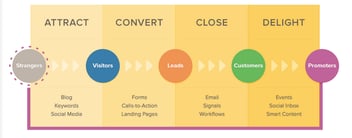
The key to great marketing is understanding what it is you’re trying to accomplish and then determining, over time, whether you accomplished that goal. To get started, refer to your company’s goals. Then, determine what marketing tools and actions will best support those goals. Consider what makes those actions successful and how you’ll measure that success. Next, set out making a plan to fulfill those actions over the course of a set period of time. Be sure to ask yourself
- What do you want to say and to whom?
- What determines the success of this strategy?
- How will I get it all done?
Identify Goals
The first rule of marketing strategy is to set goals. Marketing your business should be directly related to your sales efforts. Because increased website traffic means increased opportunities for conversions and sales opportunities, examples of sales-related marketing goals include increasing traffic to your website and increasing contact form conversion on your website.
Choose Analytics
What good are goals if you can’t tell whether you’re reaching them? Set up a way to monitor progress toward your business goals. This could be done with free website tracking software like Google Analytics or paid software like HubSpot.
Determine Appropriate Marketing Actions
So, how do you start to cause change toward these goals? Let’s dive deeper.
Increase Website Traffic
Increasing traffic to your website is a goal that you can pursue through a variety of strategies. When deciding which to implement, it’s best to determine what kind of audience you’re trying to bring to the site. Think about where your ideal customers are most likely find products or services like yours.
- You can increase traffic from Google with search engine optimization (SEO) efforts.
- You can purchase advertising to increase traffic to your site from Google Search or Display ads, social media platforms, TV, radio, and so on.
- You can drive traffic from the content your business publishes on social media platforms like Facebook, LinkedIn, Twitter.
Increase Submission of Website Contact Forms
The number of contact form submissions on your website is directly related to the amount traffic that comes to the site. When you consider your buyer personas and their buyers journeys, you’ll be able to anticipate your buyer’s needs and offer them relevant information on your site. If a website visitor finds your site content relevant and valuable, odds are better that they’ll become interested in doing business with you and fill out your contact form.
Establish Consistency
Once you’ve determined which actions to take, it’s important to plan out your marketing efforts in order to remain consistent. First, break the year down into quarters of three months each. Then, assign yourself one task per month that you will do each quarter. For example,
Month 1—Social Media
If you know that your audience actively utilizes social media to learn about products and services and you’ve used your site tracking to see that people find your site from social media sources, you can plan out your social media publishing schedule in advance. To determine your optimal publishing frequency, start where you’re comfortable and monitor the results for success over time. If your social media efforts are successful, you may see an increase in traffic to your site from social media sources.
Your task for month one is to schedule for publishing all of your social media posts for the quarter using a social media publishing tool or app like Facebook Business or HubSpot.
Month 2—Blog Publishing
Use your site’s tracking to determine which pages are most frequently visited. Use the topics of these pages to write articles to publish to your website’s blog. In this way, you can use your blog to offer your website users relevant content regarding topics you know they’re interested in based on your historical website data. To determine your publishing frequency for blog articles, start with what you know you can fulfill, and then monitor those efforts for success. If your blog is working successfully, you’ll see an increase in website traffic classified as “organic,” meaning it came from non-paid search results. You’ll be able to tell if the content you’re producing is relevant to your site visitors if the time on page increases and your blog page bounce rate decreases.
Your task for month 2 is to commit to a total number of articles you’re comfortable with and get started writing them. One or two blog articles per month is a great place to start. Remember, one a month is better than none!
Month 3—Tracking
Track your results using the platform of your choice. While this task may seem the least labor intensive of all, it’s the most important because there’s no sense in fulfilling marketing tasks if they’re not bringing success for your business. Every article you publish and every social media post you share should have an effect on your company. If it doesn’t, consider reducing that work or replacing it with other, more relevant efforts.
Your task for month 3 is to analyze the work you’ve done in the previous months and use that insight make a plan for the next 3 months.
Marketing is an experiment, so while it’s true that “something is better than nothing,” you’ll see more success if you monitor your efforts and tweak them for success. It doesn’t have to take up all your time. Make a detailed plan, and use your real site data to confirm the effectiveness of your efforts.
If you’d like help reaching your company’s marketing goals, reach out to the team at Blue Frog. We can help you develop a complete inbound marketing plan to attract your ideal customers, engage them with your business, and increase leads and sales.



